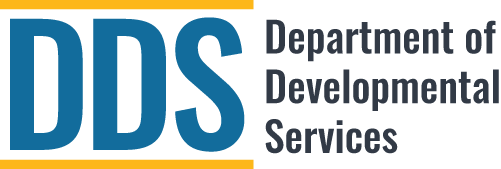When a resident of a developmental center (DC) explores living options in the community, the DC coordinates with the regional center (RC) and regional resource development projects (RRDP) to identify the services and supports needed through assessment and careful personalized planning and to ensure they are in place at the time the individual moves.
Transition Process–The process begins with the already existing Individual Program Plan (IPP) as mandated in the Lanterman Act and continues as Interdisciplinary Teams (IDTs), which include the resident, involved family members, conservators, authorized representatives, advocates, and staff who know the resident well, meet to identify each person’s goals and objectives, and services and supports based upon the assessed needs, preferences and choices. This process is used for all individuals transitioning to a new home in the community, but additional steps may be added as part of a DC closure plan.
Exploring Living Options–The transition process continues with an opportunity to explore living options that match identified service and support needs. Many elements are considered and discussed including, but not limited to:
- The variety and types of living options, housing, and program services that are available or currently being developed in the community;
- Sharing of relevant materials such as newsletters, flyers, handbooks, etc. to facilitate discussions;
- Information sessions, presentations and consultations to introduce individuals to resources;
- Design of homes (supported living, smaller group homes, family home agency);
- Day programs;
- Environmental factors (such as air quality and temperature);
- Needed medical services;
- Visits to homes to familiarize the resident and other IDT members with community living options; and,
- “Meet and Greet” introductions to potential providers to see if a specific option has a potential for success.
- The IDT documents services and supports preferences in the IPP to be discussed in conjunction with RRDP staff and RC service coordinator. Statewide training is provided to staff involved in this process to promote a culture of supporting residents throughout the transition.
Transition Planning Meeting–Once the IPP is completed and a home appropriate for placement is identified and agreed upon, a transition planning meeting (TPM) is held with the IDT to ensure a smooth transition from the DC to the home in the community. This may include more than one meeting. At this meeting a transition plan is incorporated into the IPP which includes identification of specific transition activities that are needed to ensure a smooth and successful transition. This may include the development of an Individual Health Care Plan (IHCP) for persons moving into an Adult Residential Facility for Persons with Specialized Health Care needs that would document the specific transition activities and specific transition health services, such as occupational therapy, respiratory therapy and other specialized health procedures. Specialized behavior plans are also incorporated into the IPP and developed for residents who have rights restrictions or use highly restrictive methods such as psychoactive medications to assist new providers in understanding the needs of the resident and to adequately provide the needed behavioral supports in the new home. Participants in the TPM will include, but not be limited to, the DC resident, parents when appropriate, legal guardian, conservator or authorized representative, regional center, DC staff who know the resident well, and a representative of each provider of primary services and supports identified in the IPP.
Transition Review Meeting–A transition review meeting (TRM) is held to review and finalize a resident’s ITHP and to ensure that all members of the IDT are satisfied that all arrangements agreed on in the planning process have been implemented and that the client is prepared to move. A TRM is held at the conclusion of the transition process and is the meeting when the IDT sets a move date. An individual’s TRM must occur no less than 15 days prior to a planned move date.
Follow-up After Placement–The RRDP along with the RC provide follow-up services which include regularly scheduled, as well as on an as-needed basis, contacts and visits with consumers and service providers during the 12 months following the consumer’s movement date. The RRDP will coordinate with the regional center to ensure the following:
- Participation in the development of the IPP;
- Identification of issues that need resolution;
- Arrangement of DC services including medication review, crisis services, and behavioral consultation;
- RRDP reviews occur at intervals of 5 days, 30 days, 6 months, and 12 months (at a minimum);
- Regional center face to face reviews occur no less than once every 30 days for the first 90 days.
Standardizing the Process–To enhance the current practices and establish a system-wide standard following receipt of input from several statewide stakeholder meetings, the Department is examining its processes for resident transition planning, with an emphasis on person-centered planning, communications with all stakeholders, data collection and management, and documentation. Under review at this time is an analysis of transition management, policies and procedures, and current tools for data, transition planning and diversion. A collaborative plan for implementation at each DC will be developed to ensure the safe and successful transition of each individual from a DC/CF and to monitor consistency of implementation throughout the State.
DC Task Force–Following is a summary of stakeholder comments/recommendations provided through the DC Task Force Implementation Workgroups conducted in 2014 and activities underway by the Department’s Developmental Centers Division in regards to resident transition planning:
- Transition teams need to keep the team and family informed, while allowing enough time for meetings and transition
Transition activities are currently discussed at consumer transition team meetings with the IDT which include the consumer, family and other team members. The transition meetings and activities are consumer specific in order to ensure a successful transition.
- A thoughtful 1-page summary of the individual that highlights important points, including key medical and behavioral information, would be helpful to the new provider, staff and physicians to help them get to know the person that is in transition before reviewing their entire file
Once a provider is identified, the IDT meets and cross training is completed to make sure this information is imparted to needed staff. The social workers will continue to keep all parties informed as meetings are planned and scheduled.
- A recent whole-person, standardized assessment for the individual should be available, in addition to assessments for living choice options and vocational choices, so as much as possible is known prior to transition
In addition to the standard IDT assessment, a comprehensive assessment is performed annually by the regional center, discussed by the IDT as required in the Lanterman Act, and a copy made available in the individual’s record.
- Have all supports in place prior to transitioning
The transition planning process identifies all supports and how they will be provided during and post transition into the community. - DCs should ensure that all residents have the documentation (state identification cards, green cards, birth certificates, etc.) needed to transition to the community well before transition starts
An audit will be performed and follow-up actions taken to ensure all necessary documentation is in place prior to starting the transition process. - Department of Developmental Services (DDS) Regional Project should, at a minimum, visit the new home weekly for 30 days
The regional project post placement follow up requirements are described in statute. If additional assistance is requested by the regional center, the regional project will ensure appropriate review and action is taken. - Use outcomes to evaluate the progress of the individual’s transition
DDS currently uses a nationally validated quality assessment tool that enables DDS to monitor the performance of California’s developmental disabilities service system and assess quality and performance among regional centers as required in Welfare and Institutions Code, Section 4571. The National Core Indicator (NCI) survey instrument was chosen as the quality assessment tool in 2009. NCI is a multi-state collaboration; developmental disability agencies in forty-one states and the District of Columbia voluntarily participate in the NCI program.
DDS began implementation of the NCI survey in 2010 to collect quantitative data on consumer satisfaction, provision of services, and personal outcomes. Annually, DDS conducts a survey of individuals who have moved from developmental centers. All reports of findings are reviewed by stakeholders and published on the DDS website.
The Department conducts enhanced monitoring of outcomes for individuals moving from a DC during the closure process and reports twice annually to the Legislature on outcomes in closure report updates.
In addition, regional centers monitor progress of all individuals moving from DCs to the community and evaluate outcomes through the individual program plan process. For additional information, visit the Quality Assessment, National Core Indicator’s webpage
- Collaboration of DC medical professionals with community medical professionals should be encouraged prior to, during and after transition
DC medical professionals are encouraged to communicate with community medical professionals prior to, during and after transition and are available when problems arise. - Create regional medical clinics and mobile health clinics with specialized services, not always available in the community, for individuals to utilize after leaving the DC
Outpatient clinics have previously been authorized for facilities identified for closure which provide needed services until appropriate arrangements can be established in the community. Future services will be part of ongoing planning. - Provide “Transition Insurance” or some sort of similar mechanism to cover potential costs and address different liabilities encountered by the need to provide services to DC residents while they are visiting residential and day activity options.
The process to address potential issues is to be planned and discussed at transition meetings and specific requests are evaluated and addressed by the regional project.
Last modified: April 9, 2019



